page 2
| SCM 1 | SCM 2 | SCM 3 |
Progressive Thinkers as of 5/8/2020
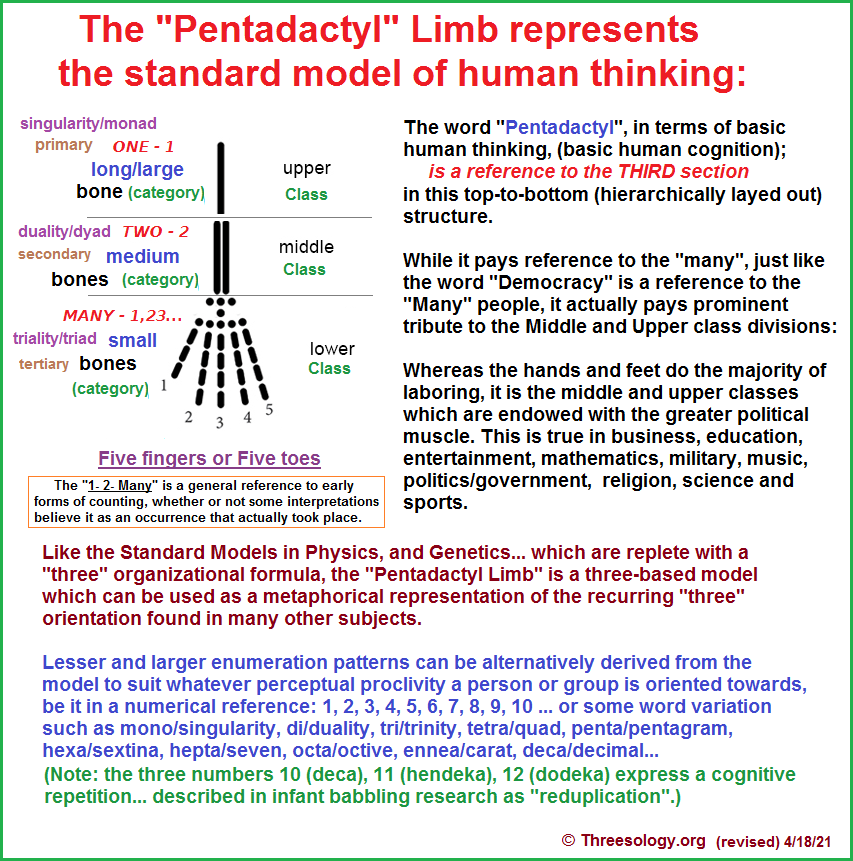
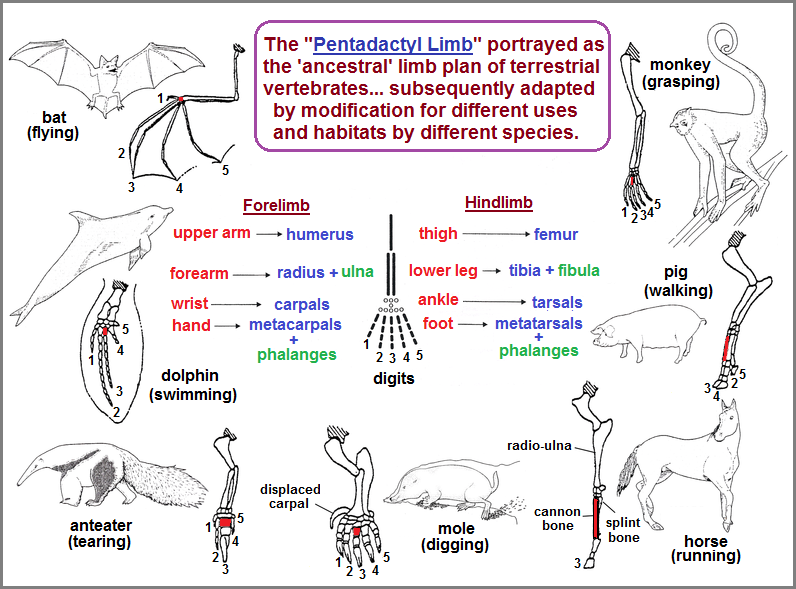
The puzzle of the human mind is that it is a puzzle for which different people perceived different topics (landscape, seascape, cosmological, biological, etc...) as "The" picture on the front of the puzzle box; which they then use in an attempt to put pieces/fragments together after they have arranged them according to some orientation which may have been developed in isolation or on the academic production line... if not compounded by multiple perspectives from different vantage points using personalized forms of bio-feedback and experimentation in altering one's consciousness by way of enhancing or restricting some physiological sensory channel.
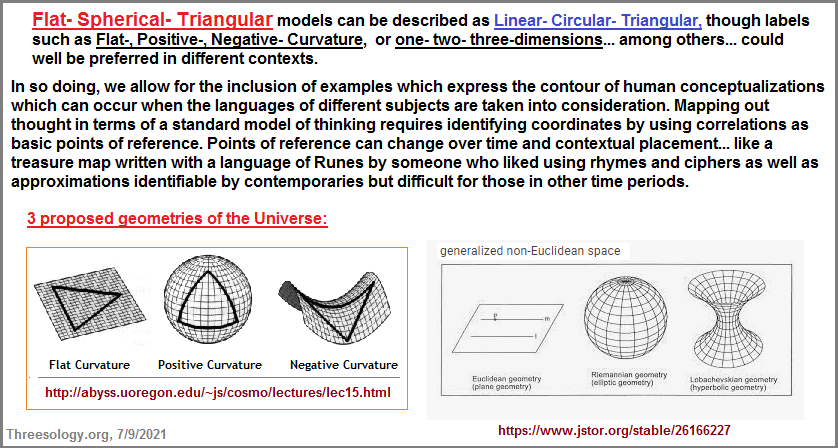
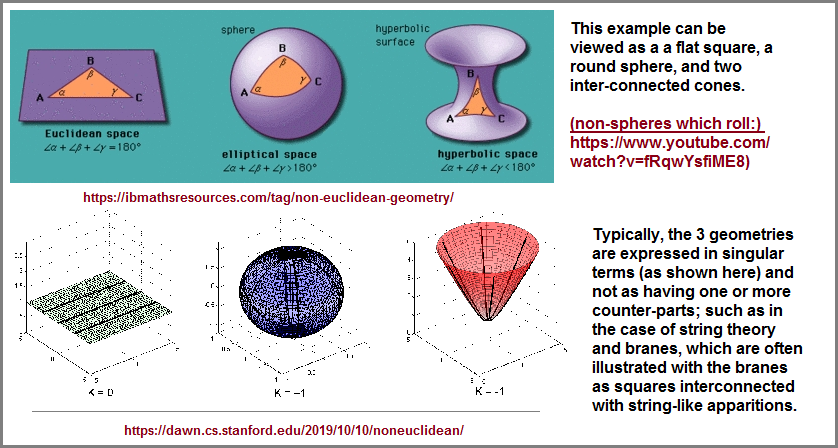
Typically, we come across the idea of string theory coupled to the notion of "branes" derived from the word "membrane" but in physics is used to describe the idea of dimensions having a boundary. And just like biology we find arguments or suppositions which attempt to illustrate conjectures of observations illustrated with the mediums respective of a given subject. In the case of physics, the color palette of choice is mathematics. In warehouse work, the pallet of choice is made of wood, though the spaces in wooden pallets is not routinely viewed in the same sense of offering different selections of mathematical equations or color combination until one attempts to palletize different size boxes on a given pallet. Choosing the right wooden pallet for a given size of container or goods to be shipped is like choosing which color is best for a painting or which equation is best for a particular subject's criteria. All of them present the respective user with "holes", with string-like interconnections, and levels of application which can be labeled as mem-branes, if one's vocabulary and mindset allow for such uses. In the case of a wooden pallet, the "strings" are sometimes made of wood. In the case of an artist's palette, the strings are blotches of mixed paint used for color variation. While "color" is a consideration in particle physics, the "sounds" (vibrations) of particle configurations has not yet reach a common usage of everyday orientation.
While the idea of "branes" is common, the commonality also is to display them in terms of a square or the first selection of the three universe geometries. We do not commonly come across illustrations which use circular or spherical representations for strings and branes, nor the usage of triangles. The following is a thrown-together attempt to provide some semblance of using spheres and triangles for the strings and brane theories, though some readers may prefer to use other standard or non-typical geometrically configured diagrams:
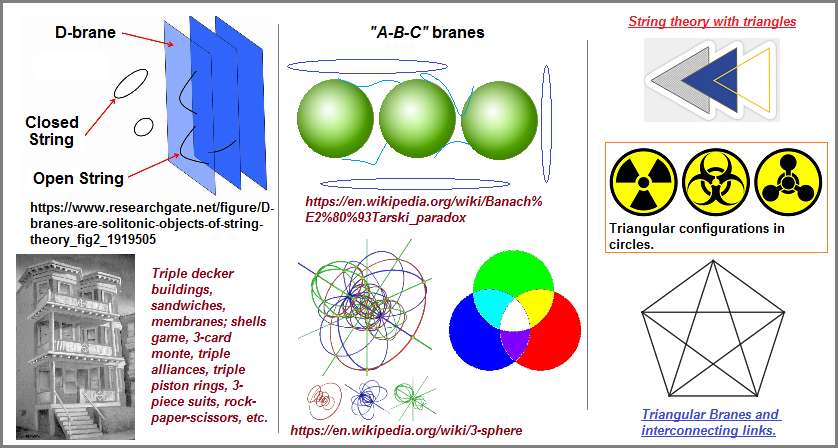
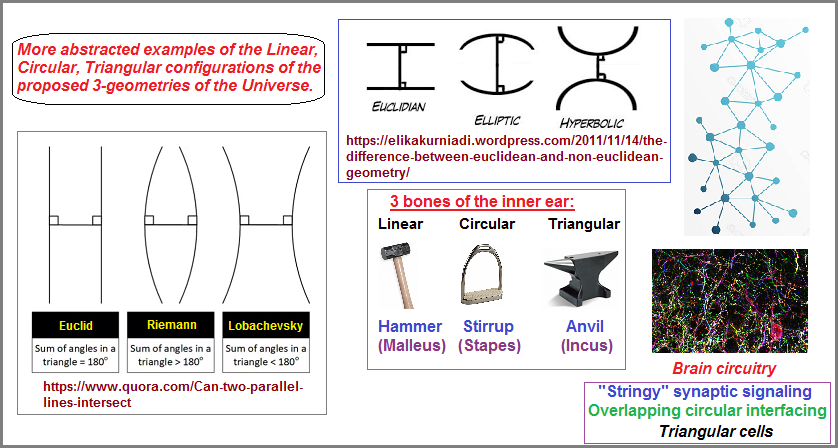
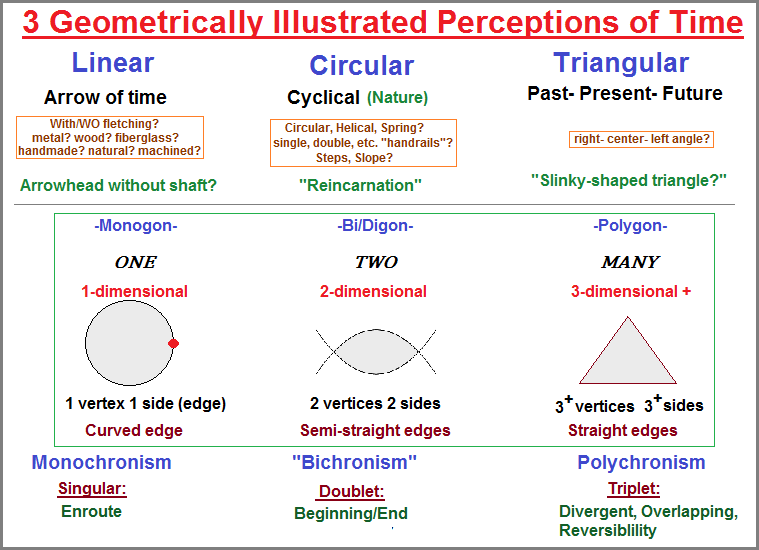
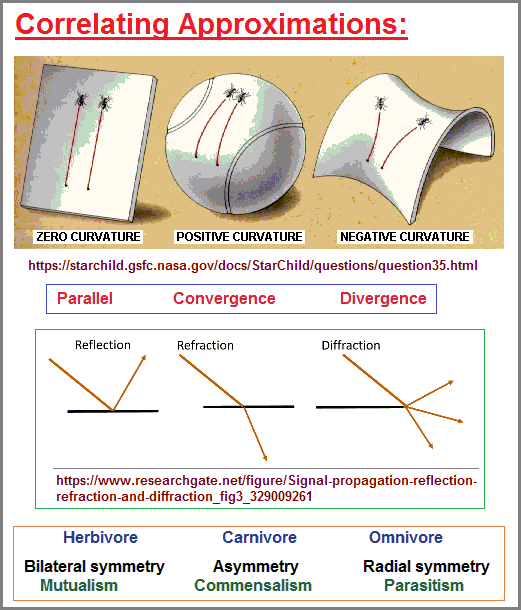
We seek out patterns. Sometimes it is of need to combine information and ideas from more than one subject area in order to uncover commonalities of occurrence which are concealed due to habitat of occurrence. In this case, "habitat" can refer to culture, language, and subject matter spanning the length of human existence as it has been affected by influences from micro- and macro events such as those occurring on the atomic, genetic, planetary and larger cosmological areas. Whereas we say that humans are affected by events in nature, and some speculate that larger planetary activities play a role in guiding or at least determining aspects of our lives, we can use a broad-minded approach when examining the 3 basic fingerprint patterns labeled Loop, Whorl and Arch. However, there are variations to these three and some anomalous appearances and even cases of Adermatoglyphia, which is a lack of fingerprints. Nonetheless, there is an established three-patterned basic world standard because most people have similar patterns.
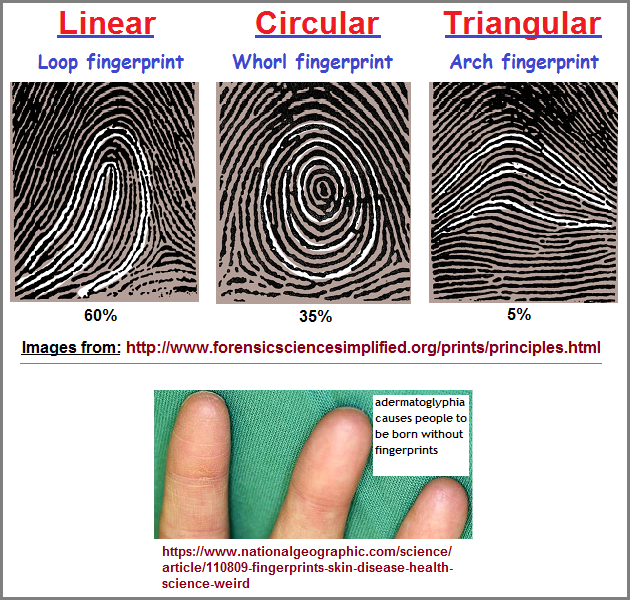
If we view such patterns as biological representations of larger cosmological possibilities, then we notice that the patterns are embedded by surrounding lines that we may... for instance, label as eddy currents, or visible magnetic fields in a vacuum confronting an object. (Yet if the three fingerprint patterns can viewed in such a manner, can not there also be other 'microscopic' biological references to influential macroscopic influences... even external to Earth's pressures?)
To me, in making connections with the three basic geometric forms labeled as Linear, Circular, Triangular, though you may prefer other labels; it of need to temporarily extract the forms from the surrounding "eddy" currents and allow for the labels to be expressed as objects subjected to external forces which distort the images to portray the type of "field distortions" they exhibit. Granted that this terminology may be crude or insufficient for some readers, it nonetheless provides for some measure of footing upon which to provide some beginning perspective for further examination... whatever language and symbolism one has a preference for.
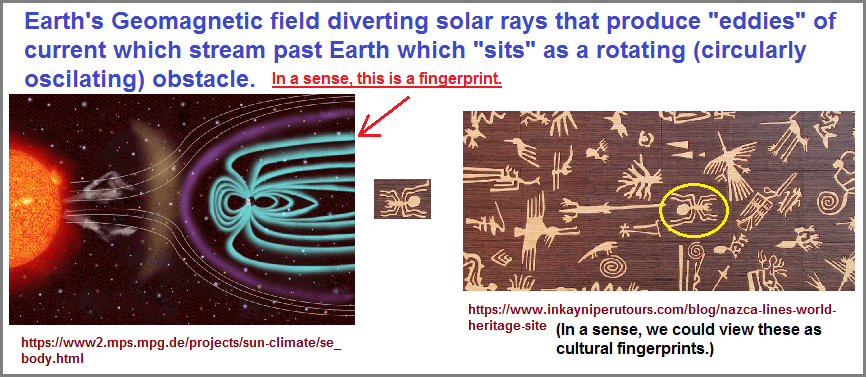
Eddy currents of magnetism would be difficult to visibly see with the naked eye if they are dark lines occurring in the darkness of space, be it called dark matter, dark energy, or some other current trend in naming such phenomena... and if no other objects are nearby to provide a hint that they are present.
We must ask ourselves if we have a straight line, is the line singular, double, triple or otherwise? Are we confronted by three different types of string theory or three different types of forces which can affect a single string theory in three different ways? What force(s) is/are necessary to make a relative straight line bend into what can be described as a linear loop, a circular whorl, and a triangular arch? Are we thus confronted by three forces:
- That which the line itself exerts.
- External to the line.
- That which occurs to prevent the line from fully collapsing inward such as a so-called dark energy conducive to such a line?
Is there layering to dark matter/dark energy... hence, making the idea of "Branes" (as in mem-brane) more accommodating?
Do these patterns reflect a single type of manifold space, three different types of manifold space, or three possibilities which can be distorted by what appear sometimes to be mathematical forms of gaming or "fudging" the numbers as occurs with some accountants predisposed to a particular result?
Is/Are the presumed object(s) stationary, with a "current" flowing around it? Are the object(s) moving in a given direction? Are they instead vibrating/Oscillating? Do the patterns reflect open/closed and midway string theory positioning? Are the objects passive, assertive (standing their ground) or out-right aggressive?
Why is human physiology receptive and reactive to certain impressions but not others? Why exhibit an impression of quantum physics but not geophysics? In other words, why do we not see a physical example of the Earth's geomagnetic field as an easily recognizable portrait, as one might see environment affecting tree rings or the long-term moon's growth ring affects in fossil corals and shells and ancient photosynthetic bacteria layers, called stromatolites? The Moon's Influence On Us. Are fingerprints a type of growth ring or some other cosmological representation (not to be defined in some superstitious way)?
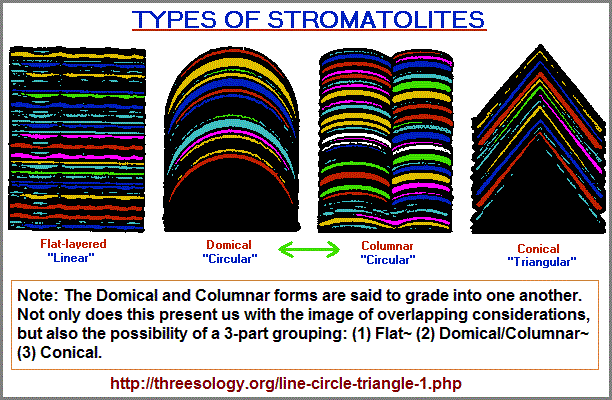
If we add the word "radiological" (associated with atomic) to the lineup of the three (ABC) weapons of mass destruction ensemble, we see another 3-to-one ideological configuration noted in the ideas of:
- Three dimensions of space and one of time
- Three stop codons and 1 start codon
- Mendelian 3-to-1 genetic ratio
- Three amino acids the same (adenosine-cytosine-guanine) and one is different: thymine/uracil (for DNA and RNA)
- Three-to-one directions; with the word "and" as a point of demarcation, like the comma in a series of numbers: North, South, East "and" West
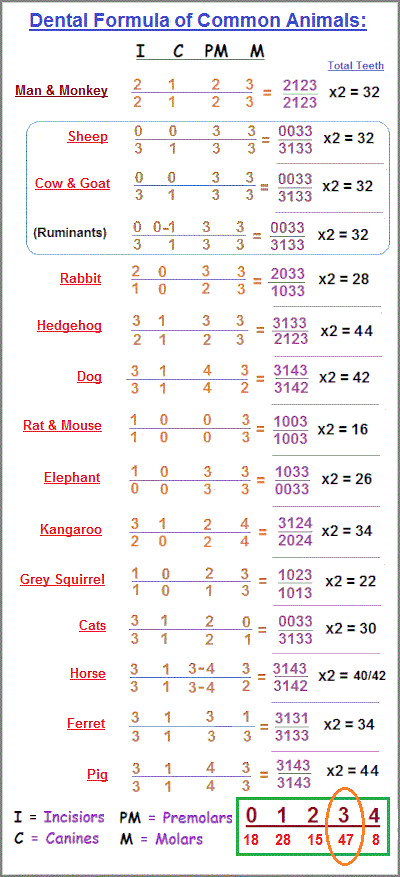
An example of a physiological dimension of the three-to-one ratio, along with distinctive three-patterned organizations and developmental sequencing can be found in human teeth. While is it claimed there are four types of teeth, the usage of pre-molar followed by molar and then third molars, presents us with a three-to-one in the form of three and then an ensemble of three or two and then the third with a group of three. The quantity of roots expressing 1-2-3 configurations suggests a developmental sequence if we assume that "1" represents a more primitive or early stage of development and the 2-root followed by a 3-root pattern reflecting later arriving developments. And yes, there are anomalies. For instance, you may find yourself with four roots in a given tooth. Some people might have jaws too small for a full 32 teeth compliment. Let us not confuse anomalies with recurring consistencies as an attempted maneuver to throw a wrench into a working idea. A larger excursion into teeth can be found here: Anatomical, Biological and Physiological Threes page 1. Clearly biology and physiology provide us with transitional or intermediate models in some cases. It it rather stupid to think that what we perceive today is somehow representative the final end result of evolutionary processes, even if in some cases this means we are observing the death knell of a given process/function or structure.
- Incisors
- Canines
- Pre-molars...
- Molars
Or.....(1) Incisors (2) Canines/ (3) premolars- molars- 3rd molars
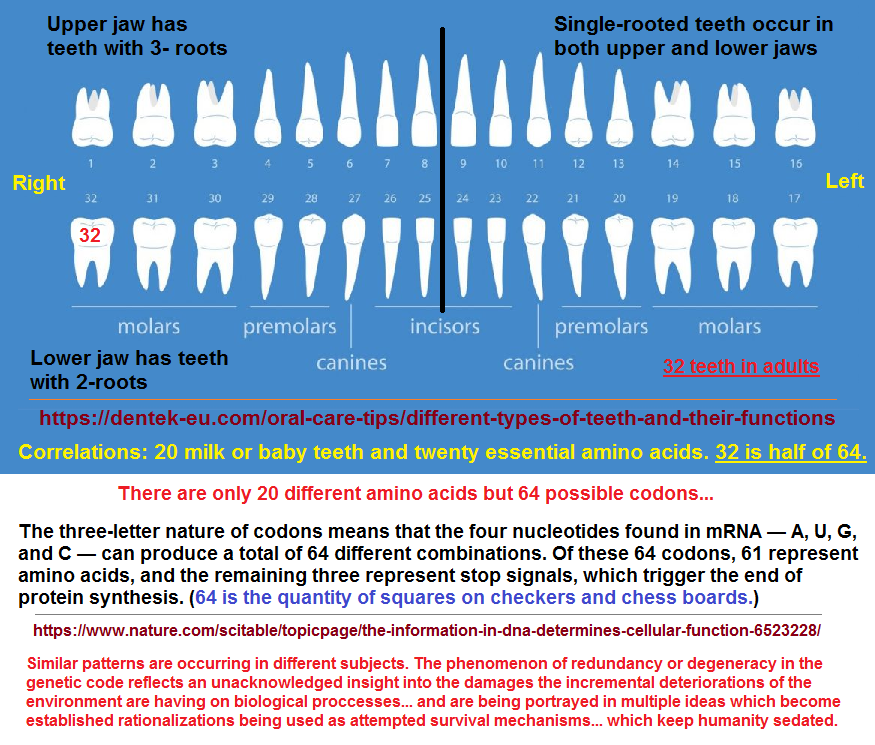
Let us also make a comparison of different teeth to show what is termed a dental formula. Notice the 0, 1, 2, 3 quantity, though other species such as the pig can display a difference: " For permanent teeth, pigs exhibit a dentition formula of 3/3, 1/1, 4/4, 3/3 or three incisors, one canine, four premolars, and three molars on each side of the top and bottom of the mouth for a total of 44 teeth." (Pig Tooth Enamel Formation).
Other examples of the three-to-one ratio exist in a variety of forms such as: While there are only three weapons of mass destruction symbolically outlined, the usage of four different symbols creates a three-to-one portfolio:
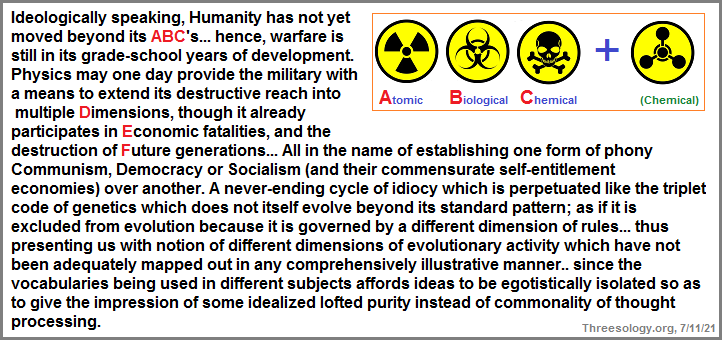
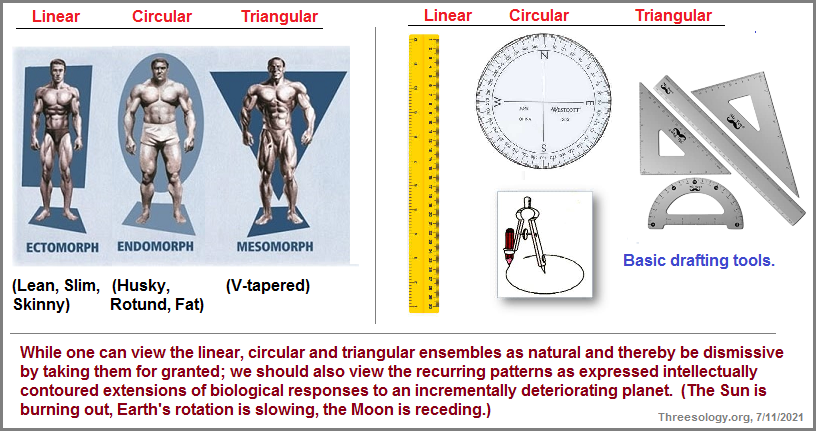
We find an interesting recurrence with the added flavor of another 1-2-3 formula if we look past the typical left/right brain hemisphere listings and involve the presence of enumeration, which leads us to the point of having to add the frequently dismissed lower brain functions as mere contributors to the two hemispheres, like smaller countries playing a kow-towing subservience to dominant Western and Eastern countries much in the role of an indentured-for-life role without either a voice or name for itself, though without which the so-called "higher" brain functionalities (or large economies) would soon find themselves in poor conditions... if able to survive for long without such basic providers of labor and their ability to use basic resources most advantageously.
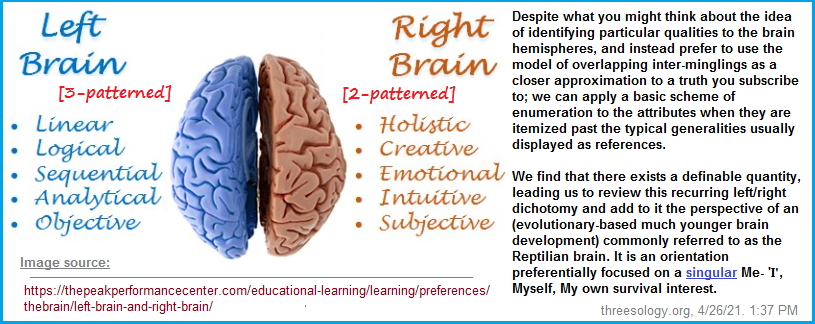
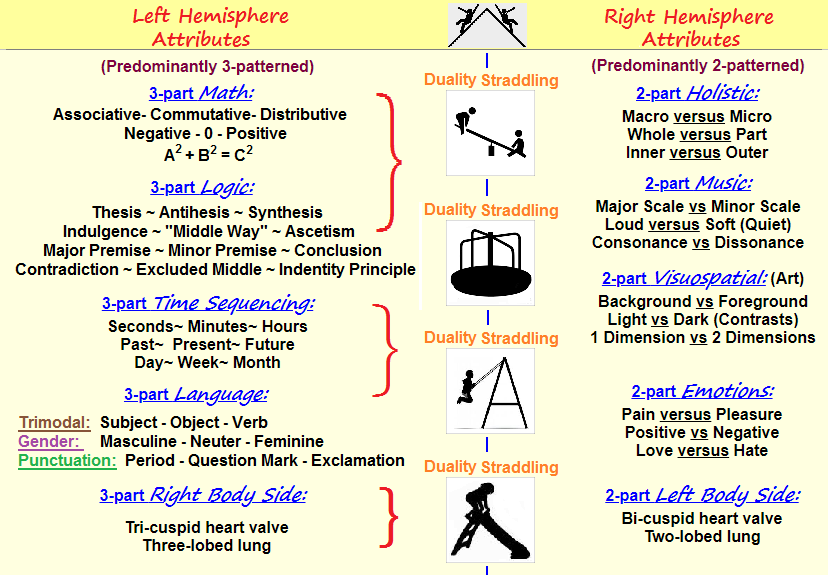
Here are some other considerations to the brain attributes enumeration profile:
- If we use the left hemisphere attributes to analyze either the right hemisphere or reptilian complex (early vertebrate brain structures
such as the brain stem and cerebellum), we find there is an inclination to view activities in a tri-partite organizational format which can
include geometric illustrations such as the use of a triangle, which may be inverted or overlapped with other imagery including other
triangles to form different configurations... which includes multiples there-of or even fractional counterparts which equal the same, such
as describing three equal lines but never using a term such as an equilateral triangle. (Left Hemisphere "analyzing" Right
Hemisphere and Reptilian complex:)
- Holistic or Holistic/partial may acquire the additional term such as "Synergy" and/or "Unity"; yin/yang acquires a term such as unity: (yin-unity-yang)
- Music dichotomies can develop a Triadic structure or a triadic structure becomes viewed as a dominant theme amongst the presence of multiple dichotomies
- Art (contrasts) can acquire a 3rd dimension perspective or 3-color (trichromatic) theory
- Emotion can be assigned words (in a 3-word grouped fashion) such as (Compassion, Patience, and Empathy)
- Dualities and singularities take on a tripartite theme
- If we use the right hemisphere attributes to examine the left hemisphere and reptilian complex, we find a proclivity to arrange items
into patterns-of-two which may be alternatively labeled as dichotomies, dualities, bi-lipid, con-, co-, as well ad multiples or fractions
there-of to conceal the usage of such a pattern (perhaps under some circumstances) by suggesting something other than the actual
functionality of using a pattern-of-two. In other words, instead of describing three components, one will use a word to encapsulate the
three into a representative duality. (right hemisphere attributes to examine the left hemisphere and reptilian complex:)
- Math trichotomies (1 + 2 = 3), (3 - 1 = 2), (3 ÷ 1 = 3), (1 x 2 = 2) may be seen as a dichotomy such as Give & Take
- 3-part Logic (Major Premise-Minor Premise-Conclusion) may become a Mind/Body or Nature/Nurture, etc., dichotomy (that philosophers argue about for centuries)
- 3-part Time divisions become related to a dichotomy such as Life & Death
- Tri-modal Language is perceived as High & Low pitch
- Triplicities and singularities take on a dualistic theme.
- If we use the reptilian complex to generate its hyper-vigilant perceptions of reality, we seen an indulgence in singular themes such as the "ONE" god, or the "ONE" universe, or Nationalism (singular group identity), or Ego-centricity (the "Chosen People"), or the "Number 1" team, or singular best performance, performer, player, entity, etc... We also have themes such as a centralized government, head of state, group leader, GUT (Grand Unified Theory), TOE (Theory of Everything)... to which we might want to humorously include other three-lettered anatomical references with their own variations the reader might indulging create for the letter grouping of: EAR, EYE, RBC (red blood cells), WBC (white blood cells), etc., all of which involve taking a pattern-of-three (or multiple) and reinterpreting or reconfiguring them to illustrate a singularity. In other instances patterns-of-two (or multiples) consistent with the right hemisphere are "translated" into representing some singular perspective.
or those interested in more intensive studies due to laterlization differences during development, here's an example:
The right brain hemisphere is dominant in human infants
by C Chiron, I Jambaque, R Nabbout, R Lounes, A Syrota, O Dulac
Abstract
The development of functional brain asymmetry during childhood is confirmed by changes in cerebral blood flow measured at rest using dynamic single photon emission computed tomography. Between 1 and 3 years of age, the blood flow shows a right hemispheric predominance, mainly due to the activity in the posterior associative area. Asymmetry shifts to the left after 3 years. The subsequent time course of changes appear to follow the emergence of functions localized initially on the right, but later on the left hemisphere (i.e. visuospatial and later language abilities). These findings support the hypothesis that, in man, the right hemisphere develops its functions earlier than the left.
It is interesting to note how prominent a usage of the 1- 2- and 3- pattern can be used in different cultures, but no one is cataloguing them as a representation of a recurring cognitive theme. Let us take for example the usage of the fingers in some hand gestures, though one might want to cite higher numbers being sometimes displayed in some circumstances. I shall provide two well-known finger-symbol displays (at least to westerners), and then several representations of the "three"-fingered expression that some generalize by calling all such illustrations as a Three-finger salute but in actual practice is not a salute but a sign of solidarity and like-minded recognition. The word "salute" is being used by single-minded journalists who want to frame all perceptions into some personalized rendition of interpretation instead of fully appreciating the usage of a particular symbol in a given context:
 |
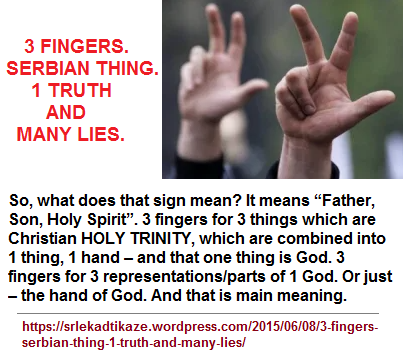 |
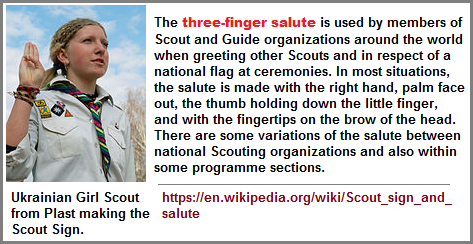 |
 |
 |
 |
 |
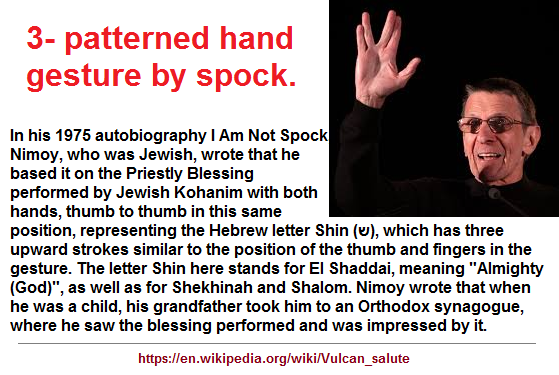 |
 |
|
 |
|
The three-finger grip is a common preference among many, though there are other grips available:
- 3 finger grip (lifting weights or gymnastics)
- 3-finger golf swing drill
-
Top 3 Grip Positions for Finger-board Training (For rock climbing) involving
three distinctions:
- Level of specificity
- Robustnus of soft tissue structures
- Transfer of strength training into your performance
- Gripping the bowstring
- With respect to holding a pen, pencil, or paint brush... either 2, 3, or 4 finger grips can be used. With respect to the three- and four-finger models, they are often labeled as Dynamic or Lateral tripod and similarly as Dynamic or lateral quadrupod. (With respect to paint brushes, there is a "creative license" which is used to hold the brush in any manner a given artist may think to experiment with, including the usage of their mouth, toes, etc... if not by extension involving some attachment.)
Note: for some readers, it is best to describe this cognitive model using the phrase A Standard Cognitive Model instead of The Standard Cognitive model since different readers may utilize a cognitive structuring formula which supplies them with a supportive cognitive rationale that suggests to them some other option. For example, they may prefer to see the basic cognitive formula in terms of a syllogism, which appropriates many guises and labeling's, but that in so very many cases the assumed tripartite structure is little more than an embellished dichotomy and not an actual 3-in-1 or 3-to-1 or 3-from-1, or 3-as-1, etc., portrayal. In this regard we can thus view multiple other examples of declarable basic/standard cognitive structures/formulas; but in collating all such supposed "standards", we find ourselves in a quandary of limitation, just as is represented in:
- A recurring triplet code in DNA (that does not appear to be evolving like other biological constructs).
- A so-called fundamental three-part macro-structure of the atom involving Protons- Neutrons- Electrons which gives the impression of a stabilized recurrence.
- A three-element composition making up over 99 percent of organic molecules: carbon- hydrogen- oxygen; not to mention the recurring currency of using solids- liquids- gases as a cognitive divisory tactic.
The idea of a "standard cognitive model" should not necessarily be interpreted to mean that it has always existed in the full formula that is being inscribed here. Just as we see in the development of humanity's sense of number along a 1- 2 - many scheme, the "standard" formula may mean a "less than full compliment" of the possible. In this sense we recognize that humanity just didn't "all of a sudden" jump into the usage of number words or a full compliment of numbers as we now recognize them. No doubt, we can consider, there were starts, stops and perhaps even some reversals of number-adopted learning due to war, disease, famine, religious persecution etc... Hence, the standard cognitive profile, despite human anatomy exhibiting one, may have been at a "one", or "one-two" sequence of development while others were already venturing into some language equivalent (three-patterned) one- two- many usage, with the word "many" being substituted with a word such as much, plenty, heap, or whatever a given people used to describe their notion of infinity or the Universe of stars.
However, nor should the reader jump to the conclusion that a linear form of enumeration best represents a given person's or people's cognitive preference of usage. In other words, while one person is quite advanced in the usage of enumeration, another person can be just as advanced or beyond by using a geometrically definable cognitive formula that they have standardized, whether or not they are consciously aware they have done so, or can readily make the illustrative distinction between their cognitive usage standard and another's. They may simply realize they think differently but have not been able to nor even considered trying to describe the underlying formulas being used. To this end, let me offer another profile of expression which appears to be a standard not only in human thinking, but multiple other activities found in other life forms. This (let us say) "standard" cognitive formula is being expressed geometrically as a linear- circular- triangular configuration, though different labels are being inter-changeably used, making correlations difficult for some observers. For example:
- Instead of "linear", the word "flat" may be used... or even the word "point"... as if one is looking at the end of a line like peering through a straw or at the tip of a pen/pencil/needle.
- Instead of "circular", the word "spherical" may be used... or even whole, mass, heap, rounded, globular, etc...
- Instead of "triangular" the word "triaxial" may be used... or even vee-shaped, X-shaped, W-shaped (as seen in combustion engines where a v-shaped configuration is used in alternate ways).
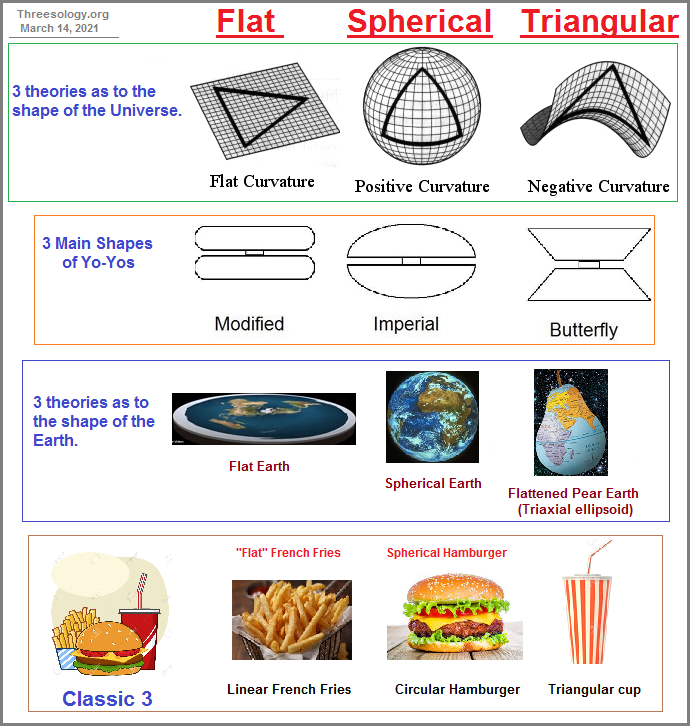
This next image gives an enumerated model related to different geometries, even though no actual number symbols are being used to describe linear, circular and triangular configurations:
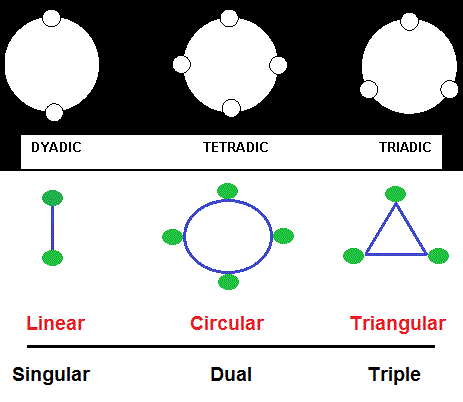
Structural Communication
Date of Origination: Saturday, 14th March 2020... 6:11 AM
Date of Initial Posting: Friday, 8th May 2020... 4:48 PM
Updated Posting: Monday, 9th June, 2025... 1:41 PM